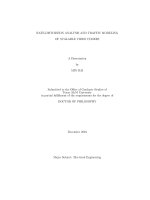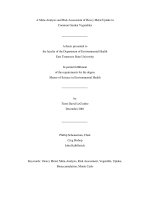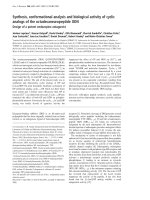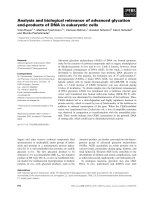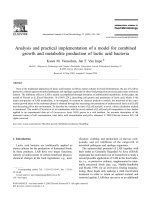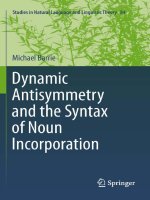Dynamic analysis and improving crashworthiness of side impact beam for saloon type vehicles
Bạn đang xem bản rút gọn của tài liệu. Xem và tải ngay bản đầy đủ của tài liệu tại đây (8.44 MB, 90 trang )
Addis Ababa University
Addis Ababa Institute of Technology
School of Mechanical and Industrial Engineering
Dynamic Analysis and Improving Crashworthiness of
Side-Impact Beam for Saloon type Vehicles
Presented in Fulfillment of the Requirements for the Degree of Master of Science
(Mechanical and Industrial Engineering)
By:
Bililign Amare
Advisor: Dr.Ing. Tamirat Tesfaye
Co-advisor: Mr. Araya Abera
June, 2017
Dynamic Analysis and Improving Crashworthiness of Side-Impact Beam for Saloon type Vehicle
2016/17
ACKNOWLEDGMENT
First of all I want to express my enormous thank to the Almighty God for his creating good
environment, continuous and priceless help to accomplish this study.
Next to God, I would like to express my sincere gratitude to my advisor Dr. Tamirat Tesfaye for
the continuous support of my research, for his patience, motivation, and immense knowledge. I
would also like to express my special gratitude to my co-advisor Mr. Araya Abera for his
guidance, support, critical comments, patience and engagement throughout the progress of the
study. Without them, this study could have not been completed.
I would also like to thank the school of Electrical and Computer Engineering for giving access to
use their advance computer for FEM analysis. This access was accomplished by the help of two
dutiful men, Mr. Behailu Mammo and Mr. Fistum; that is why I would like to thank them a lot.
Last but not list, I would like to thank my family and my friends those who are always beside me
and played a great role in the completion of this study.
I
SMIE
AAIT
AAU
Dynamic Analysis and Improving Crashworthiness of Side-Impact Beam for Saloon type Vehicle
2016/17
Abstract
Side impact collision of vehicle is one of the awfully hazardous crashes causing
injuries and death annually around the word. In this paper, the most important parameters
including material, geometry and rib arrangement were studied to improve the
crashworthiness during vehicle-to-vehicle side collision. In the side impact, the side door
impact structure is responsible to absorb the most possible kinetic energy. Different side
impact structures are designed as alternative structure and are modeled with CAD
software (CATIA V5) and then analyzed with FEM software (LS-DYNA with ANSYS
R15). This research had taken the present geometry and material for side impact beam
structure of Lifan-520 model as saloon car type. The side impact collision structure
analysis accomplished for different materials to compare the weight and impact behavior.
In this study, a side impact beam made of different materials and geometries were studied
by impact modeling to determine the deflection, acceleration and energy-absorption
behavior. The mentioned characteristics were compared to each other to find appropriate
material and geometry. Finally, side impact beam with crossed rib arrangement (-type)
and implication of Carbon/PEEK composite material having better specific internal
energy absorption, more stable and acceptable deflection within a limited crumple zone
are founded for improvement of crashworthiness.
Key Words: Crashworthiness, Energy Absorption, Maximum Deflection, Acceleration,
Composite Materials
II
SMIE
AAIT
AAU
Dynamic Analysis and Improving Crashworthiness of Side-Impact Beam for Saloon type Vehicle
2016/17
Table of Contents
ACKNOWLEDGMENT................................................................................................................................ I
Abstract ......................................................................................................................................................... II
List of Figures .............................................................................................................................................. VI
List of Tables ............................................................................................................................................. VIII
Chapter one ................................................................................................................................................... 1
1
Introduction ........................................................................................................................................... 1
1.1
Background ................................................................................................................................... 1
1.2
Crashworthiness ............................................................................................................................ 2
1.3
Crash Statistics .............................................................................................................................. 3
1.4
Basic Research Questions ............................................................................................................. 4
1.5
Statement of Problems .................................................................................................................. 4
1.6
Objective of the Study................................................................................................................... 5
1.6.1
General Objective: ................................................................................................................ 5
1.6.2
Specific Objective: ................................................................................................................ 5
1.7
Significance of the Study .............................................................................................................. 5
1.8
Scope and limitation of the Study ................................................................................................. 5
Chapter Two.................................................................................................................................................. 6
2
Literature Review.................................................................................................................................. 6
2.1
Related Work in side impact protection mechanism..................................................................... 6
2.2
Injury Criteria’s ............................................................................................................................. 8
2.2.1
Head Injury Criterion (HIC) ................................................................................................. 8
2.2.2
Thoracic Trauma Index (TTI) ............................................................................................... 8
NHTSA/ Standard ......................................................................................................................... 9
2.3
2.3.1
Federal Motor Vehicle Safety Standard (FMVSS 214) ...................................................... 10
2.3.2
Insurance Institute for Highway Safety (IIHS), Side Impact Test Protocol ................... 12
2.4
Requirements of side-Impact Beam ............................................................................................ 12
2.5
Collision Dynamic Modeling and Analysis Techniques ............................................................. 13
2.5.1
Finite Element Analysis ...................................................................................................... 13
2.5.2
Various Crash Test .............................................................................................................. 14
2.5.3
Test Methodologies ............................................................................................................. 16
Energy Absorption in different materials.................................................................................... 17
2.6
Factors on Energy Absorption of Composite Materials ...................................................................... 17
Common Material used for Side Crash Structures ...................................................................... 20
2.7
III
SMIE
AAIT
AAU
Dynamic Analysis and Improving Crashworthiness of Side-Impact Beam for Saloon type Vehicle
2016/17
Computer Aided Engineering (CAE) Tools used for Crash Analysis ........................................ 20
2.8
2.8.1
Ls-Dyna............................................................................................................................... 20
2.8.2
Msc Patran .......................................................................................................................... 21
2.8.3
Madymo .............................................................................................................................. 22
2.8.4
Easi Crash Dyna (ECD)..................................................................................................... 22
2.8.5
Easi-Crash Mad .................................................................................................................. 22
2.9
Implicit and Explicit Philosophy................................................................................................. 23
2.10
Common Element used in Crash FE Analysis ............................................................................ 23
Chapter Three.............................................................................................................................................. 24
3
Research Methods, Materials and Procedures .................................................................................... 24
Modeling of side-impact Components ........................................................................................ 24
3.1
3.1.1
Modeling of Side Impact Beam .......................................................................................... 24
3.1.2
Side-impact Beam Supporter .............................................................................................. 25
3.1.3
Front -door Trim ................................................................................................................. 25
3.1.4
Rear-door Trim ................................................................................................................... 26
3.1.5
Assembly of side impact structure ...................................................................................... 26
3.2
Side Impacting Protocol Modeling ............................................................................................. 27
3.3
Designing of Impact Beams ........................................................................................................ 29
3.4
Material for impact beam ............................................................................................................ 31
3.5
Impact Mechanics ....................................................................................................................... 32
3.6
Specific Energy Absorption Es.................................................................................................... 34
3.7
Finite Element Modeling ............................................................................................................ 35
Chapter Four ............................................................................................................................................... 41
4
Result and Discussion.......................................................................................................................... 41
Deformation ................................................................................................................................ 42
4.1
4.1.1
Total Deformation of Present Material (Steel 1006) Beam ................................................ 42
4.1.2
Total Deformation of Material One (Carbon/Epoxy) Beam ............................................... 45
4.1.3
Total Deformation of Material Two (Carbon/PEEK) Beam ............................................... 48
Acceleration ................................................................................................................................ 53
4.2
4.2.1
Acceleration of Present Material (Steel 1006) Beams ........................................................ 53
4.2.2
Acceleration of Material One (Carbon/Epoxy) Beams ....................................................... 54
4.2.3
Acceleration of Material Two (Carbon/PEEK) Beams ....................................................... 56
Internal Energy in Beam ............................................................................................................. 60
4.3
4.3.1
IV
Internal Energy of Present Material (Steel 1006) Beams .................................................... 60
SMIE
AAIT
AAU
Dynamic Analysis and Improving Crashworthiness of Side-Impact Beam for Saloon type Vehicle
2016/17
4.3.2
Internal Energy in Beam for Assignment of Material One (Carbon/Epoxy) ...................... 62
4.3.3
Internal Energy in Beam for Assignment of Material Two (Carbon/PEEK) ...................... 64
Chapter Five ................................................................................................................................................ 69
5
Conclusion and Recommendation ...................................................................................................... 69
5.1
Conclusion .................................................................................................................................. 69
5.2
Recommendation ........................................................................................................................ 70
5.3
Future Work ................................................................................................................................ 70
Reference .................................................................................................................................................... 71
APPENDIX A -----------------Material Properties/Specification................................................................. 73
APPENDIX B --------------------------Properties of Composite ................................................................... 75
APPENDIX C ---------------Meshed Model ................................................................................................ 77
APPENDIX D----------------Equivalent (Von-Mises) Stress ...................................................................... 78
V
SMIE
AAIT
AAU
Dynamic Analysis and Improving Crashworthiness of Side-Impact Beam for Saloon type Vehicle
2016/17
List of Figures
Figure 1 Crash Type...................................................................................................................................... 3
Figure 2 Fatality due to crash........................................................................................................................ 3
Figure 3 FMVSS - 214 test procedure [17]................................................................................................ 10
Figure 4 Moveable Deformable Barrier (MDB) specifications [17].......................................................... 11
Figure 5 barrier face specifications [17] .................................................................................................... 11
Figure 6 IIHS Test Configuration [14] ....................................................................................................... 12
Figure 7 Classification of various crash test used in testing ....................................................................... 14
Figure 8 Specific Energy of some materials [12]........................................................................................ 17
Figure 9 Flowchart for LS-DYNA explicit ................................................................................................ 23
Figure 10 Side Impact Beam....................................................................................................................... 24
Figure 11 Side-impact Beam Supporter ..................................................................................................... 25
Figure 12 Front -door trim ......................................................................................................................... 25
Figure 13 Rear-door Trim .......................................................................................................................... 26
Figure 14 Assembly of side impact structures ............................................................................................ 26
Figure 15 Side impact protocol NHTSA MDB .......................................................................................... 27
Figure 16 Alternative Geometry of impact beam ....................................................................................... 29
Figure 17 Flow chart of Explicit Dynamics ............................................................................................... 37
Figure 18 Total deformation in Steel 1006 beam a) Present Model b) Model One ................................. 42
Figure 19 Total deformation in Steel 1006 beam a) Model Two
b) Model Three ............................. 43
Figure 20 Total Deformation on steel 1006 beams ..................................................................................... 44
Figure 21 Minimized Deflection due to inserting rib for steel beams ........................................................ 44
Figure 22 Total deformation in Carbon/Epoxy beam a) Present Model b) Model One ......................... 45
Figure 23 Total deformation in Carbon/Epoxy beam a) Model Two b) Model Three .......................... 46
Figure 24 Total Deformation on Carbon/Epoxy beams .............................................................................. 47
Figure 25 Minimized Deformation due to inserting rib for Carbon/Epoxy beams ..................................... 47
Figure 26 Total deformation in Carbon/PEEK beam a) Present Model b) Model One ........................ 48
Figure 27 Total deformation in Carbon/PEEK bean a) Model Two b) Model Three ........................... 49
Figure 28 Total Deformation on Carbon/PEEK beams .............................................................................. 50
Figure 29 Minimized deflection due to inserting rib for Carbon/PEEK beams .......................................... 51
Figure 30 The influence of modification of material and geometry on deformation ................................. 51
Figure 31 Influence of modification of material on deflection .................................................................. 51
Figure 32 Influence of modification of geometry on deflection ................................................................. 52
Figure 33 Summary of maximum deflection .............................................................................................. 52
Figure 34 Acceleration on Steel 1006 Beams ............................................................................................. 53
Figure 35 Maximum acceleration on steel 1006 beams ............................................................................. 53
Figure 36 Minimized acceleration due to inserting ribs for steel beams .................................................... 54
Figure 37 Acceleration on Carbon/Epoxy Beams ....................................................................................... 54
Figure 38 Maximum acceleration on Carbon/Epoxy beams ....................................................................... 55
Figure 39 Minimized acceleration due to inserting ribs for Carbon/Epoxy beams ................................... 55
Figure 40 Acceleration on Carbon/peek Beams ......................................................................................... 56
Figure 41 Maximum acceleration on Carbon/PEEK beams ....................................................................... 56
Figure 42 Minimized acceleration due to inserting ribs for Carbon/PEEK beams ..................................... 57
Figure 43 The influence of material and geometry on acceleration............................................................ 58
VI
SMIE
AAIT
AAU
Dynamic Analysis and Improving Crashworthiness of Side-Impact Beam for Saloon type Vehicle
2016/17
Figure 44 Comparison of modification of material on acceleration ........................................................... 58
Figure 45 Comparison of modification of geometry on acceleration ......................................................... 59
Figure 46 Summary influence of modifying material and geometry on acceleration ................................. 59
Figure 47 Internal energy in Steel 1006 beam a) Present Model b)Model One c)Model Two d) Model
Three ........................................................................................................................................................... 60
Figure 48 Internal energy absorbed by steel 1006 beams ........................................................................... 61
Figure 49 Specific Energy Absorption of steel 1006 beams ....................................................................... 61
Figure 50 Internal energy in Carbon/Epoxy beam a) Present Model
b)Model One
c)
Model Two d) Model Three ........................................................................................................................ 62
Figure 51 Internal energy absorbed by Carbon/Epoxy beams .................................................................... 63
Figure 52 Specific Energy Absorption of Carbon/Epoxy beams ................................................................ 63
Figure 53 Internal energy in Carbon/PEEK beam a) Present Model
b)Model One
c)
Model Two d) Model Three ...................................................................................................................... 64
Figure 54 Internal energy absorbed by Carbon/PEEK beams .................................................................... 65
Figure 55 Specific Energy Absorption of Carbon/PEEK beams ................................................................ 65
Figure 56 The influence of modification of material and geometry on specific energy absorption .......... 66
Figure 57 Influence of modification of material on specific energy absorption ......................................... 67
Figure 58 Influence of modification of geometry on specific energy absorption ....................................... 67
Figure 59 Summary of influence of modifying material and geometry on SEA ........................................ 68
Figure 60 Equivalent Stress in Steel 1006 beam a) Present Model b) Model One c) Model Two d) Model
Three ........................................................................................................................................................... 78
Figure 61 Equivalent Stress in Carbon/Epoxy beam a) Present Model b) Model One c) Model Two d)
Model Three ................................................................................................................................................ 79
Figure 62 Equivalent Stress in Carbon/PEEK beam a) Present Model b) Model One c) Model Two d)
Model Three ................................................................................................................................................ 80
VII
SMIE
AAIT
AAU
Dynamic Analysis and Improving Crashworthiness of Side-Impact Beam for Saloon type Vehicle
2016/17
List of Tables
Table 1 Materials used in crash analysis ..................................................................................................... 20
Table 2 Bill of Materials ............................................................................................................................. 27
Table 3 Calculation of total mass of the modeled MDB ............................................................................ 28
Table 4 Center of gravity and moment of inertia of MDB ......................................................................... 28
Table 5 Calculation of thickness for each concept..................................................................................... 30
Table 6 Meshed statistics for the parts of model ........................................................................................ 39
Table 7 Conducted Analysis with material and model combination ......................................................... 40
Table 8 Geometry Specification of models................................................................................................. 41
Table 9 Assigned materials for models ....................................................................................................... 41
Table 10 Honey comb material property .................................................................................................... 73
Table 11 Aluminum Face Material Properties ............................................................................................ 73
Table 12 Carbon/Epoxy 40-60 Properties ................................................................................................... 73
Table 13 Carbon/PEEK 40-60 Properties ................................................................................................... 74
Table 14 Steel 1006 Properties ................................................................................................................... 74
Table 15 Basic Properties of Fibers and matrix .......................................................................................... 74
Table 16 Meshed model and statistics for the parts of model ..................................................................... 77
VIII
SMIE
AAIT
AAU
Dynamic Analysis and Improving Crashworthiness of Side-Impact Beam for Saloon type Vehicle
2016/17
Chapter one
1
1.1
Introduction
Background
Side impacts are one of the awfully hazardous crashes causing death and injuries annually
around the word. Many of these injuries occur when one car runs into the side of another or into
a fixed narrow object such as a trees lamp posts, or poles. Approximately 75% of side impact is
Vehicle-to-Vehicle collision and the rest 25% Vehicle-to-fixed object impact [1].
Over the last few decades, critical steps have been taken that increase vehicle occupant safety for
frontal impacts: mandatory driver and front-passenger airbags; improved front and rear crumple
zones; improved headrest designs; gas tank redesigns; mandatory seat-belt laws; mandatory
under ride beams on commercial trucks, and so on. Unfortunately, they do not provide similar
protection for side-impact collisions. Although frontal crashes occur more often, the type of
crash that is now more likely to result in a fatality or a serious injury is a side-impact collision
[2]. Approximately 25% of all crashes are side impacts. Over 13,000 deaths, due to side impact
occurred during 1998 in United States alone [3]. Approximately 46% of total fatalities are due to
side impacts [4].
The main difficulty in designing for side impact collision is the limited crumple zone between
the impacting vehicle and impacted occupant [5]. Strengthening vehicle body-door in side
impacts demands more attention due to having less impact zone area and lower rigidity
compared with the bumper. A good structure behavior is necessary to absorb most of the kinetic
energy.
1
SMIE
AAIT
AAU
Dynamic Analysis and Improving Crashworthiness of Side-Impact Beam for Saloon type Vehicle
2016/17
Crashworthiness may be assessed either prospectively, using computer models or experiments,
or retrospectively by analyzing crash outcome. Data obtained from a crash simulation indicate
the capability of the vehicle body to protect the vehicle occupants during a collision against
injury. Computer aided parametric design software will be used for modeling of the problem to
define all the coordinate values and geometrical details, then this CAD data would be transferred
to an FEM software (LS-DYNA, MADYMO, ANSYS etc.) for pre-processing, solution and
post-processing followed by generation and interpretation of results related to energies,
acceleration and displacements/deflections with different loads & boundary conditions possible
in various accidental situations during side collision [6].
1.2
Crashworthiness
Crashworthiness is the ability of the vehicle to absorb energy and to prevent occupant injuries in
the event of accident. Crashworthiness features includes air bags, seat belts, crumple zones, side
impact protection, interior padding and head rests.
Structural crashworthiness involves absorption of kinetic energy by considering designs and
materials suitable for controlled and predictive energy absorption. In this process, the kinetic
energy of the colliding bodies is partly converted into internal work of the bodies involved in the
crash. Crash events are non-linear and may involve material failure, global and local structural
instabilities and failure of joints. Strain-rate and inertia effects may play an important role in the
response of the structures involved.
Crashworthiness of a material is expressed in terms of its specific energy absorption. In order to
protect passengers during an impact, a structure based on strength and stiffness is far from being
optimal. Rather, the structure should collapse in a well-defined zone and keep the forces will
below dangerous accelerations. The rate of absorbing energy has also its own influence on the
brain skull. This leads the decelerated of vehicle should not greater than 20 g, [13].
2
SMIE
AAIT
AAU
Dynamic Analysis and Improving Crashworthiness of Side-Impact Beam for Saloon type Vehicle
1.3
2016/17
Crash Statistics
Side-impact crash is the second most severe crash scenario after frontal-impact. The recent crash
statistics shows that 51%, 25%, 15% and 9% are frontal, side, rollover and rear-impact,
respectively, [1, 8, 12]. As figure 1 indicates the frontal-impact is higher than the side-impact [1].
However, the space requires for any structure in the event of a side-impact to absorb energy is
very less than the frontal-impact.
Vehicle Crash
Rear
Impact
9%
Rollover
15%
SideImpact
25%
FrontalImpact
51%
Figure 1 Crash Type
The occupant injuries in the side-impact crash are severe when compared with the frontal crash.
Other crashes involved are the rear impact and rollover. These amounts are lesser crash scenario
than the side or the frontal crash. In the recent time approximately 46% of total fatalities are due
Fatality due to Crash [%]
to side impacts; and the other 54% are (fontal = 38%, rear = 6% and rollover = 10%), [4].
50%
40%
30%
20%
10%
0%
Front Impact
impacts
Side impact Rollover Impact Rear Impact
Crash Type
Figure 2 Fatality due to crash
3
SMIE
AAIT
AAU
Dynamic Analysis and Improving Crashworthiness of Side-Impact Beam for Saloon type Vehicle
2016/17
1.4 Basic Research Questions
Which types of structure and geometry will be appropriate for absorbing high kinetic
energy with acceptable deflection in limited crumble zone during side collision?
Which available materials (inexpensive and lightweight) are suitable for side impact
beams?
Which types of geometry and material combination will absorb energy in more stable
condition with acceptable acceleration limits?
1.5 Statement of Problems
Over the last few decades, critical steps have been taken that increase vehicle occupant safety for
frontal impacts: mandatory driver and front-passenger airbags; improved front and rear crumple
zones; improved headrest designs; gas tank redesigns; mandatory seat-belt laws; mandatory
under ride beams on commercial trucks, and so on. Unfortunately, they do not provide similar
protection for side-impact collisions, [2]. The main difficulty in designing for side impact
collision is the limited crumple zone between the impacting vehicle and impacted occupant. To
avoid the occupant injuries it is necessary to absorb the whole kinetic energy both of the vehicle
and the occupant. Kinetic energy of the occupant can absorbed by using three or four point seat
belts, side air bags, padding materials and crumble zone during side collision [10]. Most
researches of side impact protection focused on low-speed (<20 km/h) impacts [3], [10], [9], [5],
[7] and also in fixed object collision [10], [5], [4], [7].
Whereas approximately 75% of side
impact is Vehicle-to-Vehicle collision and also 60% of vehicle-to-vehicle side collisions are
occurred at a speed more than 32 km/h [1]. Therefore absorbing high kinetic energy of vehicles
during high speed side collision between vehicles needs a special structure which can sustain the
effect of severe condition of side collisions. Some researchers were introduced the optimum
structure for side-impact beam [7, 8, 9] and the other researchers were investigated on
appropriate materials for side-impact structure, [11, 15]. But crashworthiness structure needs
optimum combination of structures and intended materials.
4
SMIE
AAIT
AAU
Dynamic Analysis and Improving Crashworthiness of Side-Impact Beam for Saloon type Vehicle
2016/17
1.6 Objective of the Study
There are several areas in the field of crash-impact dynamics that need to be studied to
improve the crashworthy design of the side-door.
1.6.1 General Objective:
The general objective of this study is to find a compatible side door impact-beam having
better energy absorption during severe side collision in limited crumple zone to enhance
crashworthiness.
1.6.2 Specific Objective:
Designing appropriate structure for vehicle side collision.
Identifying appropriate material for side impact structure.
Analyzing the energy absorption of different alternative of side impact structures.
1.7 Significance of the Study
This study will have a contribution to increase vehicle occupant safety for constrained
fatality or a serious injury due to side-impact collision. The study can also indicate a clue
how crashworthiness design could implement in limited crumple zone. The side impact
structure is designed from the lightweight materials, so automotive industries may use
this concept for lightweight design of vehicles parallel with occupant safety.
1.8 Scope and limitation of the Study
The study included designing of side impact structure with preparing its model and
analyzing with respect to speed of collision. The design of the structure focused on fiveseater saloon (Lifan 520) type vehicle. It analyzed the specific energy absorption of the
structure with selecting appropriate material. The failure of the bonding between the
beam tube and rib is taken as negligible and it is supposed that any set of parts is
constrained to each other in all degree of freedom without modeling the mechanical
strength of the coupled part. The crashworthiness experimental analysis is expensive and
not available in Ethiopia; this limits the study to apply only computational finite element
analysis using Computer Aided Drafting (CAD) and Computer Aided (CAE) software
such as CATIA, AutoCAD, and ANSYS_LS-DYNA. For the accuracy of the result,
experimental test should be conducted in the future work.
5
SMIE
AAIT
AAU
Dynamic Analysis and Improving Crashworthiness of Side-Impact Beam for Saloon type Vehicle
2016/17
Chapter Two
2
2.1
Literature Review
Related Work in side impact protection mechanism
Side impact protection mechanism will install in the door of vehicle. They will have
different geometries and will construct from different materials. This research focuses on
the side impact protection mechanisms by studying Lifan-520 model car. This existed
model has four side impact beams with a circular cross-section and constructed from steel
1006. Thought time to time, crashworthiness has been a growing realization of importance
in virtually every transportation sector. Newer designs are proposed every day to improve
the crashworthiness of the structure. There is no limit in the field of crashworthiness in
reducing the injuries sustained by the occupant. It is preferable to design a vehicle to
collapse in a controlled manner, thereby ensuring the safe dissipation of kinetic energy.
Panagiotis Bazios [7], discussed energy absorption and deflection of five conventional vehicle
door components (side panel, inner skin of door, outer skin of door, impact beam and hinges) of
two-seater electrical vehicle in side impact conditions. He applied dynamic structural analysis
type and found optimum thickness of the door components in order to minimize impact energy
and the intrusion of the door to the cabin. After recognizing as the impact beam is the main
impact energy absorber, he redesigned to having variable thickness.
Javier Luzon-Narro [8], presented six innovative occupant near side lateral impact protection
concepts including a dynamic door, high-volume side airbag, a large external airbag that covers
doors, sill and B-pillar of the struck vehicle and other concepts for increasing the distance
between the occupant and the door panel (active armrest, inflatable door beam and moving seat).
All systems are based on pre-crash detection of the impact and are activated as soon as 0.8
second before the impact. This paper also details the task of integrating these systems into a
vehicle using FE models, sled tests, and full scale crash tests.
6
SMIE
AAIT
AAU
Dynamic Analysis and Improving Crashworthiness of Side-Impact Beam for Saloon type Vehicle
2016/17
John Townsend [9], discussed The design and development of the side impact modular door
system for different size vehicles with and without Door and Chassis-Frame Integration
Technology (DACIT). This paper presents a side impact protective door system within the space
between the outer skin of a car door and the occupant, which will be as efficient as that already
standard in frontal impact by integrating the structural modular door with the vehicle body.
Sandeep Dalavi, [10], discussed the effectiveness of car interior door trim parts (top roll, insert,
armrest, main carrier and Ma-pocket) in reducing loads transferred to the occupant during side
impact and suggested strengthening those parts can protect injuries of side collisions.
He
indicated that addition of energy absorbing padding material in the door area can greatly improve
the energy dissipation in the car interior.
Gustavo Zini [11], indicated some feasible innovations that may lead to a better side impact
protection, pointing out some aspects that can be developed thoroughly within the corresponding
settings and using the appropriate resources. The mentioned innovations analyzed from a general
point of view, using basic engineering and physics principles. Simulations performed using a
simplified model consisting on mass spring system. The protection offered by current safety
devices analyzed, segmented into three groups (pre-impact, impact and post-impact).
Ashwin Sheshadri [12], demonstrated that the new designed composite beam with carbon/epoxy
is more effective than the present steel beam. A composite side impact beam has designed to
replace the present beam and the injuries sustained by the occupant are recorded. The research
had used Carbon/Epoxy and Glass fiber/epoxy composite materials in the designed side-impact
beam. In addition, a parametric study was carried out on the beam to determine the maximum
possible energy absorbing parameters. It demonstrated that the new designed beam with the use
of carbon/epoxy present more energy absorption than the present steel beam. Energy absorption,
displacement and the acceleration of the present and the new design were also compared and
discussed in detail. The research demonstrated that the new designed composite beam with
carbon/epoxy is more effective than the present steel beam.
7
SMIE
AAIT
AAU
2016/17
Dynamic Analysis and Improving Crashworthiness of Side-Impact Beam for Saloon type Vehicle
2.2 Injury Criteria’s
Injury criteria can be defined as a biomedical index of exposure severity, which indicates the
potential for impact induced injury by its magnitude. There are several kinds of injury criteria’s
that related to the human body. These are basically the impact loads acting on the human body.
2.2.1 Head Injury Criterion (HIC)
The head injury criterion is defined as:
∫
HIC = max [
( ) ] 2.5 (t2-t1)
( )
For, T0 ≤t1≤ t2≤ TE
Where, T0 = start time of simulation
TE= end time of simulation
R(t) = is the resultant head acceleration in g’s measured at head’s center of gravity
over the time interval T0 ≤ t ≤ TE.
t1 and t2 are the initial and final times (in seconds) of the interval during which the
HIC attains a maximum value.
In the event of an impact, crashworthy materials would have work done on them to absorb this
kinetic energy over a time frame that ensures the deceleration of the car to be less than 20g,
above which the passengers will experience irreversible brain damage because of the relative
movements of various parts of the brain within the skull cavity, [13].
2.2.2 Thoracic Trauma Index (TTI)
The thoracic trauma index (TTI) provides an indication of the severity of injuries received by
motor vehicle occupants in side-impact collision environments.
The Thoracic Trauma Index (TTI) can be defined as:
(
8
SMIE
AAIT
)
(2)
AAU
Dynamic Analysis and Improving Crashworthiness of Side-Impact Beam for Saloon type Vehicle
2016/17
Where AGE = age of the test subject in years,
RIBg = maximum absolute value of acceleration in g’s of the 4th and 8th rib on the struck side,
T12g = maximum absolute acceleration values in g’s of the 12th thoracic vertebra, in lateral
direction,
MASS = test subject mass in kg
MSTD = standard reference mass of 75 kg.
The TTI is the acceleration criterion based on accelerations of the lower thoracic spine and the
ribs. The TTI can be used as an indicator for the side impact performance of passenger cars. The
specific benefit of the TTI is that it can be used to address the entire population of vehicle
occupants because the age and the weight of the cadaver are included.
There is also a definition for the TTI that could be used for dummies without a specific age,
called the TTI (d). It is defined for 50th percentile dummies with a mass of 75 kg:
( )
(
)
(3)
The dynamic performance requirement, as stated in FMVSS 214 regulations of 1990, is that the
acceleration on the structure shall not exceed 85 g for passenger cars with four side doors and 90
g for two side doors [17].
2.3 NHTSA/ Standard
The National Highway Traffic Safety Administration (NHTSA) is an agency of the Executive
Branch of the U.S. government, part of the Department of Transportation. There are some of the
important standards/regulations related to crash situations which are referred for the modeling
and testing purpose. The Most common standard in US is FMVSS (Federal Motor Vehicle
Safety Standards) regulations [17], and the other standards are ECE (Economic Commission of
Europe) regulations in Europe, ARAI (Automotive Research Association of India), [12].
9
SMIE
AAIT
AAU
Dynamic Analysis and Improving Crashworthiness of Side-Impact Beam for Saloon type Vehicle
2.3.1
2016/17
Federal Motor Vehicle Safety Standard (FMVSS 214)
The US dynamic side impact requirement, FMVSS-214, is used to evaluate the performance of
passenger vehicles in car-to-car side crashes. FMVSS 214 was amended in 1990 to assure
occupant in a dynamic test that simulates a severe right-angle collision. It is one of the most
important and promising safety regulation issued by the NHTSA. It was phased into new
passenger cars during model years 1994-97. In 1993, side impacts accounted for 33% of the
fatalities to passenger car occupants. The current FMVSS 214 is a culmination of many years of
research to make the passenger car less vulnerable in side impacts and especially to reduce
fatalities risk to the nearside occupant, when a car is struck in the door area by another vehicle.
This modeling protocol is more familiar than Insurance Institute for Highway Safety (IIHS), Side
Impact Test Protocol, which is described in the next article, [17].
This study applied the FMVSS for modeling the impacter. The test configuration as specified by
the National Highway Traffic Safety Administration (NHTSA) is shown in the next figure.
Schematically, a moving deformable barrier (MDB) is shown impacting the side of a stationary
vehicle at 54 km/h (33.5 mph). The MDB is towed at a crabbed angle of 27o to its longitudinal
axis. This configuration is intended to simulate a striking generic vehicle moving at 48.4 km/h,
perpendicular to the side of the struck vehicle traveling at 24.2 km/h. The crabbed angle
configuration allows the simulation of a two-vehicle side impact, both in motion condition, using
a simplified test method where only one vehicle is in motion.
Figure 3 FMVSS - 214 test procedure [17]
10
SMIE
AAIT
AAU
Dynamic Analysis and Improving Crashworthiness of Side-Impact Beam for Saloon type Vehicle
2016/17
The NHTSA MDB represents an average passenger vehicle in the US. The following figure
shows the MDB’s specifications. The MDB consists of the following components [17]:
Main frame assembly
barrier face
Hub assembly
Rear guide assembly
Axle assembly
The geometrical specifications of the MDB are shown in the next figure.
Figure 4 Moveable Deformable Barrier (MDB) specifications [17]
The barrier face specifications of the MDB are shown in the next figure.
Figure 5 barrier face specifications [17]
11
SMIE
AAIT
AAU
Dynamic Analysis and Improving Crashworthiness of Side-Impact Beam for Saloon type Vehicle
2016/17
2.3.2 Insurance Institute for Highway Safety (IIHS), Side Impact Test Protocol
The Institute’s side impact test is relatively very severe. Given the design of today’s vehicles, it
is unlikely that people in real world crashes, as severe as this test would emerge uninjured.
However, with good side impact protection, people should be able to survive crashes of this
severity without serious injuries.
Figure 6 IIHS Test Configuration [14]
In this test procedure the crash is similar to the one used in Federal Motor Vehicle Safety
Standard (FMVSS 214) but the wheels on the moving deformable barrier(MDB) are aligned with
the longitudinal axis of the cart (zero degrees) to allow for 90 degree impact with velocity of 50
Kph(31 mph).
2.4 Requirements of side-Impact Beam
Federal Motor Vehicle Safety Standards (FMVSS) No. 214 establishes the minimum strength
required for side doors of passenger cars. The side doors must be able to withstand an initial
crush resistance of at least 2,250 pounds after 6 inches of deformation, and intermediate crush
resistance of at least 3,500 pounds (without seats installed) or 4,375 pounds (with seats installed)
after 12 inches of deformation. A peak crush resistance of two times the weight of the vehicle or
7,000 pounds whichever is less(without seat installed) or 3-1/2 times the weight of the vehicle or
12,000 ponds whichever is less(with seats installed) after 18 inches of deformation [13].
The major factors in considering the materials for the side door are load path and maximum
resisting load of the door. The load carrying capacity and intrusion of the side door structure
12
SMIE
AAIT
AAU
Dynamic Analysis and Improving Crashworthiness of Side-Impact Beam for Saloon type Vehicle
2016/17
mainly depends on mechanical properties, shape, size and thickness of its components. The
proper combination of these features can dramatically change the behavior of the structure,
providing an efficient design [12].
2.5 Collision Dynamic Modeling and Analysis Techniques
2.5.1 Finite Element Analysis
Simulation using finite element method comprises of three major phases:
Pre-processing, in which the analyst develops a finite element mesh to divide the subject
geometry into sub domains for mathematical analysis, and applies material properties and
boundary conditions,
Solution, during which the program derives the governing matrix equations from the
model and solves for the primary quantities, and
Post-processing, in which the analyst checks the validity of the solution, examines the
values of primary quantities (such as displacements and stresses), and derives and
examines additional quantities (such as specialized stresses and error indicators).
13
SMIE
AAIT
AAU
Dynamic Analysis and Improving Crashworthiness of Side-Impact Beam for Saloon type Vehicle
2016/17
Various Crash Test
2.5.2
A crash test is a form of destructive testing usually performed in order to ensure safe design
standards in crashworthiness and crash compatibility for various types of vehicle like small,
medium and heavy duty and its related systems and components for the sake of getting the
performance of the vehicle under the different conditions of crash at different angles with taking
certain object like rigid wall, cables specially three-strand cable, concrete barriers, guardrail
systems etc. It will be performed either by numerical simulations or experimentally. The
following figure depicts different types of crash test generally used.
Crash Test
Side Impact
Test
Offset
Test
Frontal
Impact Test
Small
overlap Test
Roll Over
Test
Right Hand
Offset Impact
Left Hand Offset
Impact
Central
Impact
Roadside
Hardware
Figure 7 Classification of various crash test used in testing
14
SMIE
AAIT
AAU
Old versus
New
Dynamic Analysis and Improving Crashworthiness of Side-Impact Beam for Saloon type Vehicle
2016/17
Side Impact Test- In this test sometimes the vehicle is in static condition or in dynamic
and another vehicle or an object collide at the side surface having some speed.
Offset Test- In this test only a part of front portion of the vehicle strikes on some barrier
usually a vehicle at a given speed.
Frontal Impact test- In this test a fully front structure of the vehicle collides with another
object like another vehicle, rigid wall etc. at a given speed.
Small Overlap Test- In this only a small portions of the vehicle strikes an object like tree,
pole or if a car were to clip another. This situation loads a maximum value of force into
the vehicle structure at a particular given speed. This test usually comprises of 15% to
20% of the front structure.
Roll-Over Test- In this test a vehicle is in rollover condition having certain angle by
which they tests ability (specifically the pillars holding the roof) to support itself in a
dynamic impact. It is also done for the static crash testing condition.
Roadside Hardware- These are performed to ensure that the crash barriers and crash
cushions will protect vehicle occupants from roadside hazards.
Old Versus New- In this an impact is done between old car against a new car and the big
car against a small car; it is performed to show the advancements in crashworthiness.
15
SMIE
AAIT
AAU

